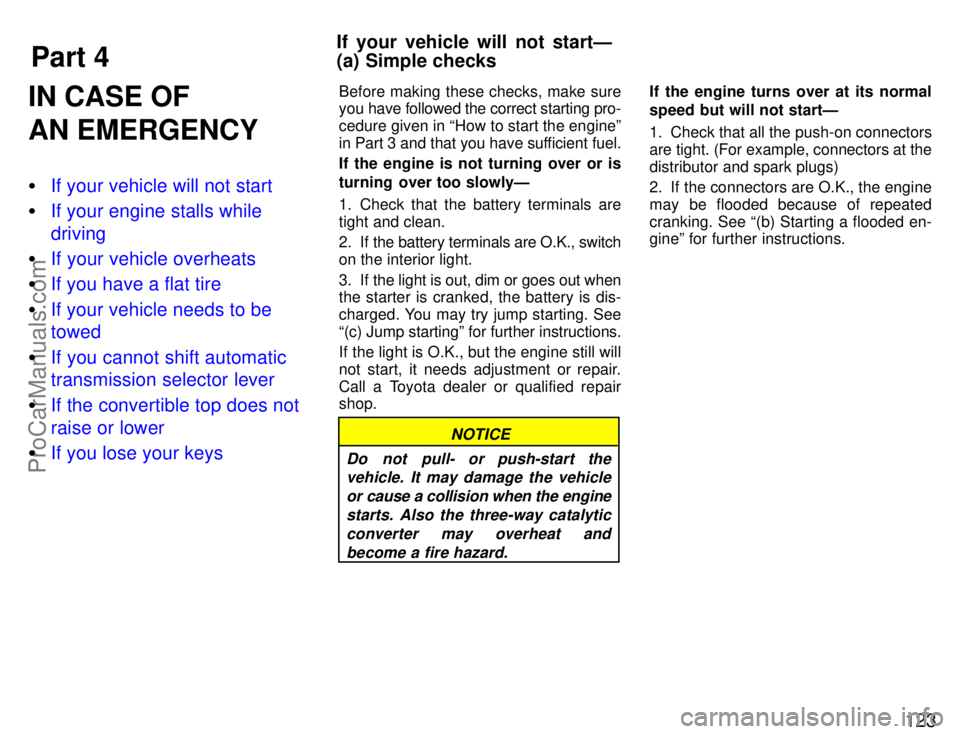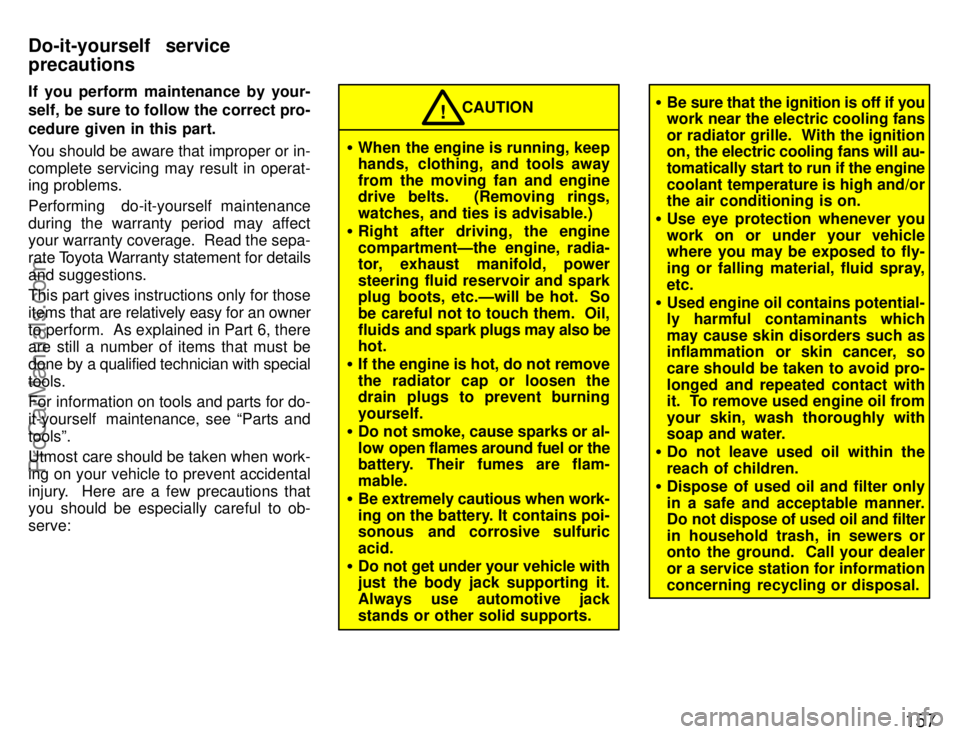Page 130 of 203

Part 4
If your vehicle will not startÐ
(a) Simple checks123
IN CASE OF
AN EMERGENCY
�If your vehicle will not start
� If your engine stalls while
driving
� If your vehicle overheats
� If you have a flat tire
� If your vehicle needs to be
towed
� If you cannot shift automatic
transmission selector lever
� If the convertible top does not
raise or lower
� If you lose your keys
Before making these checks, make sure
you have followed the correct starting pro-
cedure given in How to start the engineº
in Part 3 and that you have sufficient fuel.
If the engine is not turning over or is
turning over too slowlyÐ
1. Check that the battery terminals are
tight and clean.
2. If the battery terminals are O.K., switch
on the interior light.
3. If the light is out, dim or goes out when
the starter is cranked, the battery is dis-
charged. You may try jump starting. See
(c) Jump startingº for further instructions.
If the light is O.K., but the engine still will
not start, it needs adjustment or repair.
Call a Toyota dealer or qualified repair
shop.
NOTICE
Do not pull- or push-start the vehicle. It may damage the vehicle
or cause a collision when the enginestarts. Also the three-way catalyticconverter may overheat andbecome a fire hazard.
If the engine turns over at its normal
speed but will not startÐ
1. Check that all the push-on connectors
are tight. (For example, connectors at the
distributor and spark plugs)
2. If the connectors are O.K., the engine
may be flooded because of repeated
cranking. See (b) Starting a flooded en-
gineº for further instructions.
ProCarManuals.com
Page 164 of 203

157
If you perform maintenance by your-
self, be sure to follow the correct pro-
cedure given in this part.
You should be aware that improper or in-
complete servicing may result in operat-
ing problems.
Performing do-it-yourself maintenance
during the warranty period may affect
your warranty coverage. Read the sepa-
rate Toyota Warranty statement for details
and suggestions.
This part gives instructions only for those
items that are relatively easy for an owner
to perform. As explained in Part 6, there
are still a number of items that must be
done by a qualified technician with special
tools.
For information on tools and parts for do-
it-yourself maintenance, see Parts and
toolsº.
Utmost care should be taken when work-
ing on your vehicle to prevent accidental
injury. Here are a few precautions that
you should be especially careful to ob-
serve:
� When the engine is running, keep
hands, clothing, and tools away
from the moving fan and engine
drive belts. (Removing rings,
watches, and ties is advisable.)
� Right after driving, the engine
compartmentÐthe engine, radia-
tor, exhaust manifold, power
steering fluid reservoir and spark
plug boots, etc.Ðwill be hot. So
be careful not to touch them. Oil,
fluids and spark plugs may also be
hot.
� If the engine is hot, do not remove
the radiator cap or loosen the
drain plugs to prevent burning
yourself.
� Do not smoke, cause sparks or al-
low open flames around fuel or the
battery. Their fumes are flam-
mable.
� Be extremely cautious when work-
ing on the battery. It contains poi-
sonous and corrosive sulfuric
acid.
� Do not get under your vehicle with
just the body jack supporting it.
Always use automotive jack
stands or other solid supports. CAUTION
!�
Be sure that the ignition is off if you
work near the electric cooling fans
or radiator grille. With the ignition
on, the electric cooling fans will au-
tomatically start to run if the engine
coolant temperature is high and/or
the air conditioning is on.
� Use eye protection whenever you
work on or under your vehicle
where you may be exposed to fly-
ing or falling material, fluid spray,
etc.
� Used engine oil contains potential-
ly harmful contaminants which
may cause skin disorders such as
inflammation or skin cancer, so
care should be taken to avoid pro-
longed and repeated contact with
it. To remove used engine oil from
your skin, wash thoroughly with
soap and water.
� Do not leave used oil within the
reach of children.
� Dispose of used oil and filter only
in a safe and acceptable manner.
Do not dispose of used oil and filter
in household trash, in sewers or
onto the ground. Call your dealer
or a service station for information
concerning recycling or disposal.
Do-it-yourself service
precautions
ProCarManuals.com
Page 165 of 203

158
NOTICE
�Remember that battery and igni-tion cables carry high currents or
voltages. Be careful of accidental-ly causing a short circuit.
�Add only demineralized or dis-tilled water to fill the radiator. Andif you spill some of the coolant, besure to wash it off with water to
prevent it from damaging theparts or paint.
�Do not allow dirt or anything elseto fall through the spark plugholes.
�Do not pry the outer electrode of aspark plug against the center elec-
trode.
�Use only spark plugs of the speci- fied type. Using other types willcause engine damage, loss of per-
formance or radio noise.
�Do not reuse platinum-tipped
spark plugs by cleaning or regap-ping.
�Do not overfill automatic trans-
mission fluid, or the transmissioncould be damaged.
�Do not drive with the air cleaner fil-ter removed, or excessive engine
wear could result. Also backfiringcould cause a fire in the enginecompartment.
�Be careful not to scratch the glass
surface with the wiper frame.
�When closing the engine hood,check to see that you have not for-gotten any tools, rags, etc.
Here is a list of parts and tools you will
need on performing do-it-yourself main-
tenance. Remember all Toyota parts are
designed in metric sizes, so your tools
must be metric.
Checking the engine oil level
Parts (if level is low):
� Engine oil API SH, Energy-Conserv-
ing IIº multigrade or ILSAC multigrade
having viscosity proper for your cli-
mate
Tools:
� Rag or paper towel
� Funnel (only for adding oil)
Checking the engine coolant level
Parts (if level is low):
� Ethylene-glycol antifreeze
� Demineralized or distilled water
Tools:
� Funnel (only for adding coolant)
Checking brake fluid
Parts (if level is low):
� SAE J1703 or FMVSS No. 116 DOT 3
brake fluid
Tools:
� Rag or paper towel
� Funnel (only for adding fluid)
Parts and tools
ProCarManuals.com